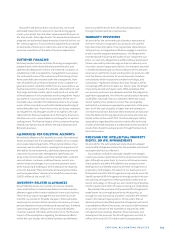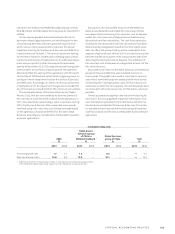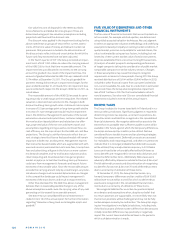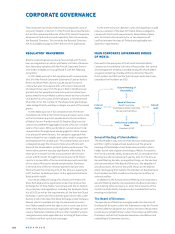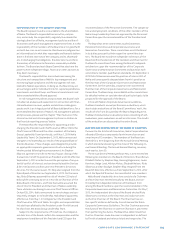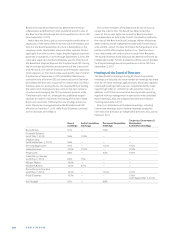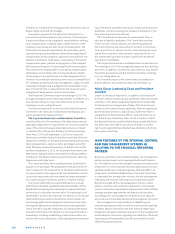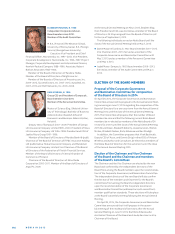Nokia 2013 Annual Report Download - page 114
Download and view the complete annual report
Please find page 114 of the 2013 Nokia annual report below. You can navigate through the pages in the report by either clicking on the pages listed below, or by using the keyword search tool below to find specific information within the annual report.NOKIA IN 2013
112
members of the Board: Henning Kagermann (Chairman), Bruce
Brown, Helge Lund and Kari Stadigh.
The primary purpose of the Personnel Committee is to
oversee the personnel policies and practices of the company.
It assists the Board in discharging its responsibilities relating
to all compensation, including equity compensation, of the
company’s executives and their terms of employment. The
Committee has overall responsibility for evaluating, resolv-
ing and making recommendations to the Board regarding ()
compensation of the company’s top executives and their em-
ployment conditions, () all equity-based plans, () incentive
compensation plans, policies and programs of the company
aff ecting executives and () other signifi cant incentive plans.
The Committee is responsible for overseeing compensation
philosophy and principles and ensuring the above compen-
sation programs are performance-based, designed with an
intention to contribute to the long-term value sustainability of
the company, properly motivate management, support overall
corporate strategies and are aligned with shareholders’ inter-
ests. The Committee is responsible for the review of senior
management development and succession plans.
The Personnel Committee had nine meetings in . The
average attendance at the meetings was %. In addition, any
director who wishes to, may attend Personnel Committee
meetings as a non-voting observer.
For further information on the activities of the Personnel
Committee, see “Executive compensation philosophy, pro-
grams and decision-making process”.
The Corporate Governance and Nomination Committee
consists of three to fi ve members of the Board who meet all
applicable independence requirements of Finnish law and the
rules of the stock exchanges where Nokia shares are listed,
i.e. NASDAQ OMX Helsinki and the New York Stock Exchange.
From May , until September , , the Corporate
Governance and Nomination Committee consisted of the fol-
lowing four members of the Board: Risto Siilasmaa (Chairman),
Henning Kagermann, Jouko Karvinen and Helge Lund. After
Risto Siilasmaa assumed the position of Nokia’s interim CEO
and since September , , the Corporate Governance and
Nomination Committee has consisted of the following three
members of the Board: Jouko Karvinen (Chairman), Henning
Kagermann and Helge Lund.
The Corporate Governance and Nomination Committee’s
purpose is () to prepare the proposals for the general meet-
ings in respect of the composition of the Board and the direc-
tor remuneration to be approved by the shareholders and ()
to monitor issues and practices related to corporate govern-
ance and to propose necessary actions in respect thereof.
The Committee fulfi lls its responsibilities by (i) actively
identifying individuals qualifi ed to become members of the
Board and considering and evaluating the appropriate level
and structure of director remuneration, (ii) proposing to the
shareholders the director nominees for election at the Annual
General Meetings as well as the director remuneration, (iii)
monitoring signifi cant developments in the law and practice
of corporate governance and of the duties and responsibili-
ties of directors of public companies, (iv) assisting the Board
and each Committee of the Board in its annual performance
evaluations, including establishing criteria to be used in con-
nection with such evaluations, (v) developing and recommend-
ing to the Board and administering our Corporate Governance
Guidelines, and (vi) reviewing the company’s disclosure in the
Corporate Governance Statement.
The Committee has the power to retain search fi rms or
advisors to identify candidates. The Committee may also
retain counsel or other advisors, as it deems appropriate.
The Committee has the sole authority to retain or terminate
such search fi rms or advisors and to review and approve such
search fi rm or advisor’s fees and other retention terms. It is
the Committee’s practice to retain a search fi rm to identify
new director candidates.
The Corporate Governance and Nomination Committee had
fi ve meetings in . The average attendance at the meetings
was %. In addition, any director who wishes to, may attend
Corporate Governance and Nomination Committee meetings
as a non-voting observer.
The charters of each of the committees are available on
Nokia’s website, www.company.nokia.com/en/about-us.
Nokia Group Leadership Team and President
and CEO
Under its Articles of Association, in addition to the Board of
Directors, Nokia has Nokia Group Leadership Team (previously,
until May , Nokia Leadership Team) that is responsible
for the operative management of Nokia. The Chairman and
members of the Nokia Group Leadership Team are appointed
by the Board of Directors. Nokia Group Leadership Team is
chaired by the Chief Executive Offi cer. Only the Chairman of
the Nokia Group Leadership Team can be a member of both
the Board of Directors and the Nokia Group Leadership Team.
The Chief Executive Offi cer also acts as President, and his
rights and responsibilities include those allotted to the Presi-
dent under Finnish law.
MAIN FEATURES OF THE INTERNAL CONTROL
AND RISK MANAGEMENT SYSTEMS IN
RELATION TO THE FINANCIAL REPORTING
PROCESS
Nokia has a Risk Policy which outlines Nokia’s risk management
policies and processes and is approved by the Audit Commit-
tee. The Board’s role in risk oversight includes risk analysis and
assessment in connection with business planning and reviews,
updates and decision-making proposals. Risk oversight is an
integral part of all Board deliberations. The Audit Committee
is responsible for, among other matters, the risk management
relating to the fi nancial reporting process and assisting the
Board’s oversight of the risk management function. Nokia
applies a common and systematic approach to risk manage-
ment across business operations and processes with the Nokia
strategy and plans approved by the Board as the baseline.
Accordingly, the risk management at Nokia is not a separate
process but a normal daily business and management practice.
The management is responsible for establishing and
maintaining adequate internal control over fi nancial reporting
for Nokia. Nokia’s internal control over fi nancial reporting is
designed to provide reasonable assurance to the management
and the Board of Directors regarding the reliability of fi nancial
reporting and the preparation and fair presentation of pub-
lished fi nancial statements.



